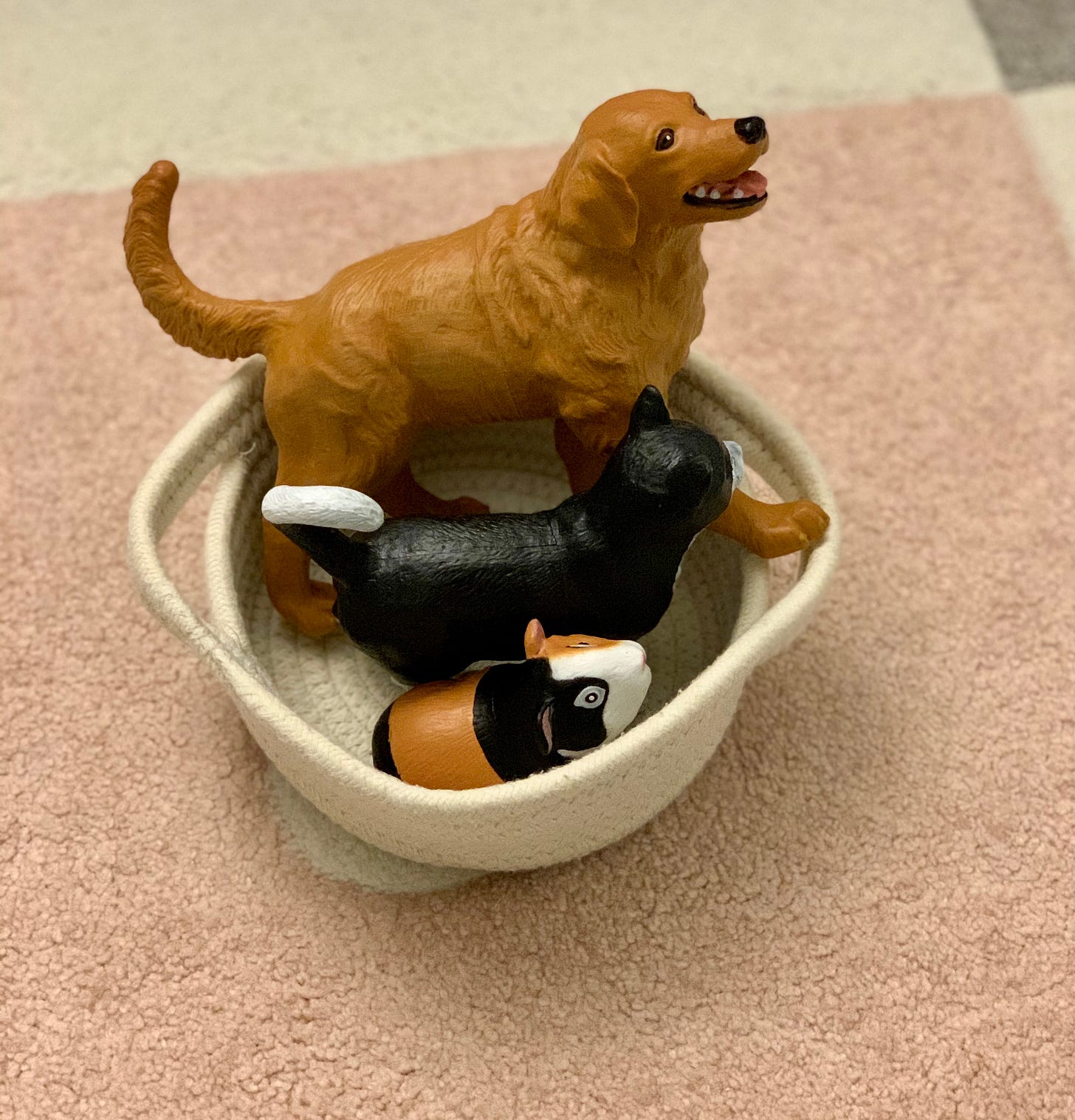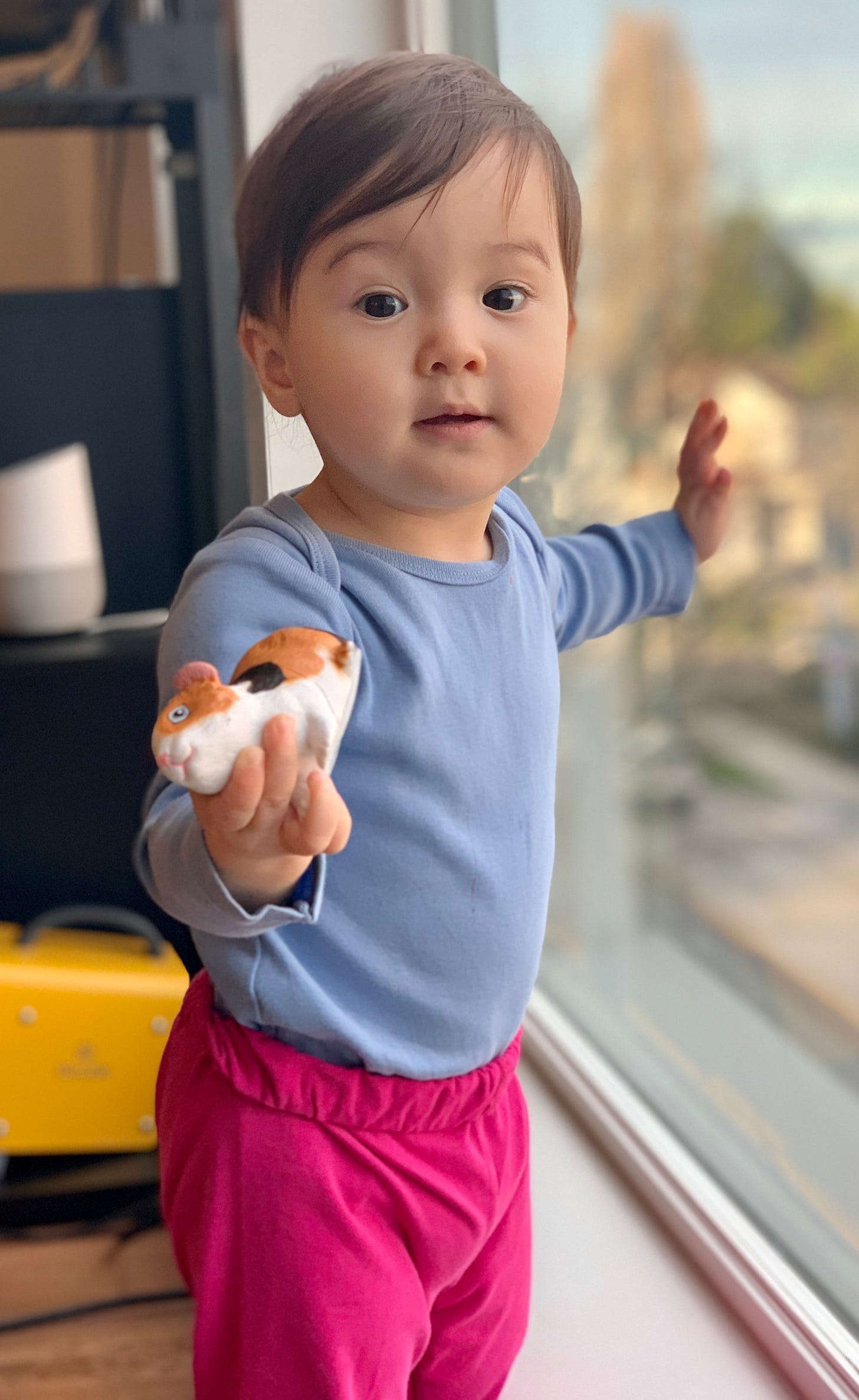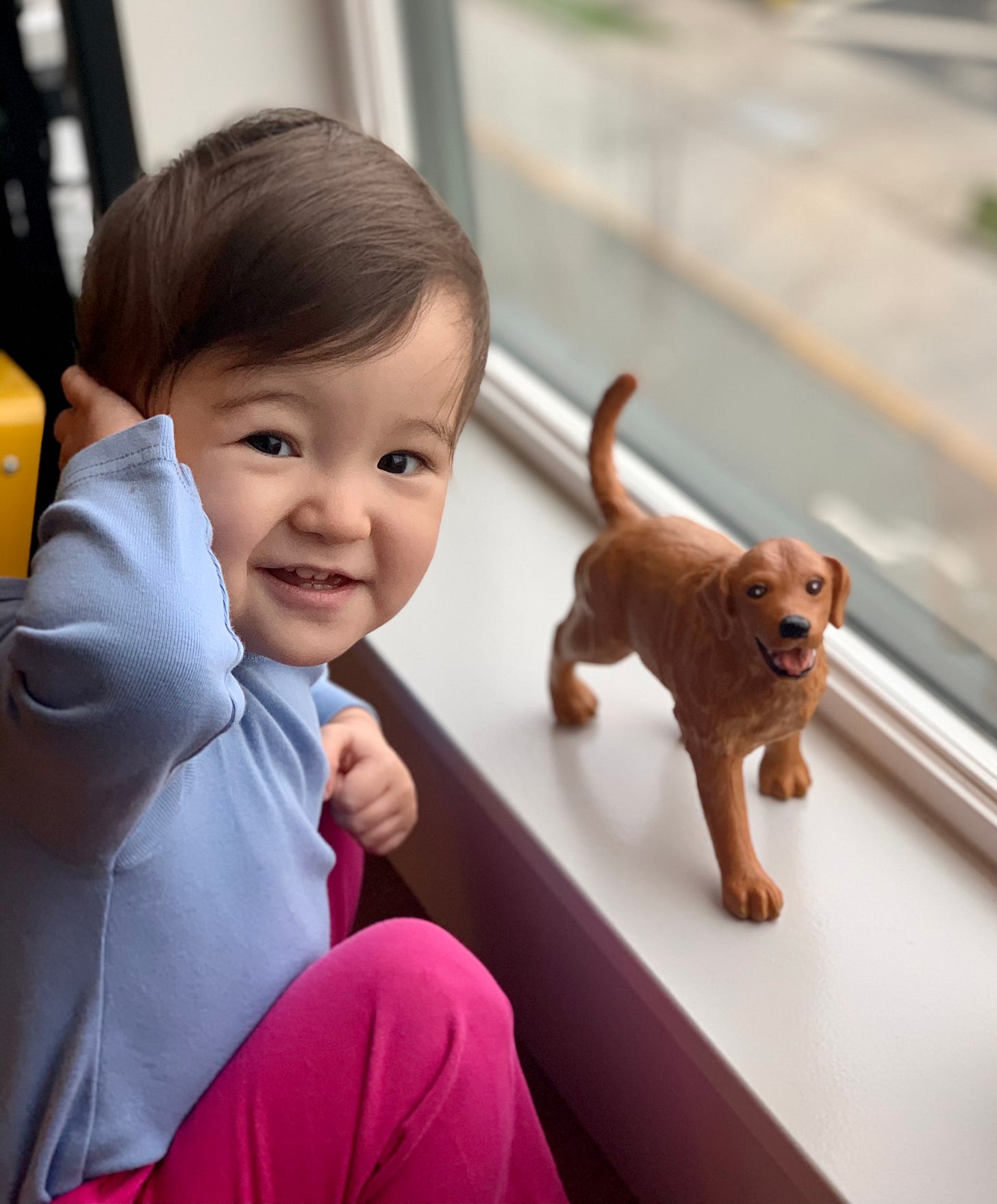Building Your Child's Vocabulary
A Montessori Approach to Vocabulary Building, Incorporating Vocabulary in sensory play, and Three Great Resources!
I think watching their child learn to speak and say their first words are some of the most exciting milestones for parents. For me, it is so exciting watching L learning to speak. It is so fun to be able to communicate with her so much more! At 14.5 months, L is constantly babbling and trying to copy our sounds and words. She has a handful of words that she uses with some consistency. I love hearing her play around with sounds and when she gets it right, she glows!
Language Baskets vs. Treasure Baskets
I thought this would be the perfect time to introduce her to language baskets! We have done Montessori treasure baskets since L was around five months old. These are sensory baskets for infants to explore usually around a theme. For example, the color yellow or (baby safe) kitchen objects. Babies crave touching, mouthing, and experiencing different objects- especially objects common around your house. These baskets give the opportunity to do just that! You can read more about treasure baskets here and here. A language basket is the same concept as a treasure basket, but with the intent being for the child to expand their vocabulary by first exploring the objects and then have the objects be named.
For younger toddlers (such as L), language baskets are kept simple. Only three or four objects (usually around a theme again) are in the basket at once. For older toddlers and preschoolers, introducing more objects according to the child’s ability is fine. It is important that the objects you choose to be as realistic as possible if you can’t use the real object itself. If you are introducing fruit name, you can put the real fruit in the basket and help your child experience it through naming it, exploring it, cutting it open, smelling it, eating it, etc. For objects that you can’t put the real thing in a basket, using a life like replica is best. First, let your child explore the basket on their own as they show interest. For L’s first basket, I chose three pets that she sees everyday (a dog, a cat, and a guinea pig). She loves all animals, especially the cat and guinea pig in her life! Teaching functional vocabulary (words that they encounter everyday) first is important. I make sure all the objects in her language baskets apply directly to her everyday real life. Teaching other functional first words such as “up”, “eat”, “yes”, and L’s favorite: “this” are important too and can easily be taught through interaction everyday.
Part One: Naming
Once your child has had the opportunity to explore the objects on their own, you can begin to simply name the objects as they interact with them. When L picks up the dog, I tell her “Dog”, or “That is a dog”, using the only correct name for the animal (not doggie, puppy, or woof-woof). For her age, only one word or a very short sentence is enough. This is the first part of the three part lesson: naming.
In pre-verbal toddlers, you might know it is time to move to the second part of the lesson when you see them look in the direction of the object you name or when they respond positively after you have named the object. For example, when L is holding the cat and looks at me, I say “cat”, and she will look down at the cat or try to hand it to me. For more verbal toddlers, they might try to say the name of the object. Recently, L tries to say “cat” (she is actually saying “cat-at”).
Part Two: Recognition
The second part of the lesson is recognition. Here would could ask your toddler “where is the dog?” or “show me the dog.” and they would attempt to do so. It is important to note that it is best not to correct your child. They might loose motivation and interest. Instead, you might say “that is the cat” (when they had that to you instead of the dog), or “Here is the dog”. This part of the lesson take the longest time, think in terms of several days to a week or more depending on your child. Young children need to hear the names of things many, many times. Be patient and play lots of games (“I spy”, “Can you hide the dog behind your back?”, “peek-a-boo”)! For younger children, the lesson might stop here, especially if they are not speaking at all yet. For older children, you can have them match the object in the basket to a picture of the same object or one that looks very similar if you can’t find the same (cats of the same color in the same pose).
Part Three: Cognition
The third part of the lesson is cognition, remembering the vocabulary. Remember not to move on this this part of the lesson unless you are certain your child knows the vocabulary. In this part of the lesson, you might ask your child “what is this?” and they would provide the name. If they make a mistake try hard to use positive reinforcement instead of “no, that is the cat”, you can say “here is the dog”. L is currently not quite ready for this part as she calls all the animals “cat-at” or “Tora” (our cat’s name). For older toddlers and older children, this can be turned into a matching game. They can match the object in the basket to a similar looking, yet slightly different photo of the object. For example, if they were learning about vehicles, you might provide a replica city bus and a photo of a city bus that is a different color or style.
For resources about teaching your child functional language, check out the Speech Sisters here or on instagram. You can find more information about Montessori language baskets along with some great ideas here and here.
A Couple of Great Resources for Parenting From this Week
The past couple of weeks have been full of great articles, podcasts, classes, and books coming out! It was hard to just pick a couple to share with you!
Pre-ordering for “The Montessori Baby” book by Simone Davis, author of “The Montessori Toddler” and Junnifa Uzodike is now open!
You can sign up here to pre-order and find out more about what I am sure is going to be a wonderful book. “The Montessori Toddler” is one of my favorite books and is what inspired me to start this newsletter! I highly recommend it and can’t wait to read “The Montessori Baby”. I am sure it would also make a great gift for any new or expecting mother!
From the website: “The Montessori Baby draws on the child-led principles of the Montessori educational method to foster a first year defined by love, respect, understanding, and a surprising sense of calm.”
The book will talk about creating a “yes” space for baby, how less is more when it comes to little ones, slowing down and avoiding rushing through care times, and how to set up your home for baby in a Montessori way.
Check out this wonderful article by Teresa of Montessori in Real Life on seven phrases to diffuse toddler frustration.
This is a great article and so timely as L has been getting frustrated more recently. This article is a simple read and very direct, so check it out!
Here are a couple of phrases that from the article that I find helpful with L:
“I hear you.” I use this a lot. This is just to remind L that I am here for her. I know she is feeling frustrated and I am listening to her. I also use it to give myself a second to figure out if and how I can help her and to make sure I am in a calm place to respond to her.
“You are working really hard on that!” This phrase puts the attention back on the process they are going through rather than their final product when working on a task. We are putting the value on their hard work and effort they are making (even if it isn’t working out) and they feel appreciated regardless of the outcome.
Janet Lansbury (who coined the term “respectful parenting”)’s daughters came on her podcast to talk about it was like being raised by respectful parenting methods and how it impacted their life.
You can find the podcast here. They answer questions about what their upbringing was like and if they noticed a difference between the way they were being raised vs their peers.
They answer a wide variety of questions, but they both repeatedly come back to how grateful they were for the way they were raised. They admit that they went through rebellious stages still and probably could have been made to persevere a bit more with piano lessons, but they feel grateful that their mom listened to their input about what they wanted to do and learn. They both emphasis the amazing relationship they are able to have with their mom and credit it to the way they were raised.
This podcast is a great testimony to raising children with respect and trust, but not being permissive. It gets to the heart of what respectful parenting is all about. I highly recommend you to take a listen! I hope that L has similar things to say when she grows up!
Language Basket Sensory Play
L really loved interacting with her language basket pets all week, but was getting less interested at the end of the week, so I decided to include them in her sensory bin tonight! She loved it! It was a whole new experience for her.
I simply made a bin with some rice, a scoop, a small jar, some pompoms and the cat and guinea pig from her language basket (the dog was too big). As she played with them, I kept naming them when she looked at me (I didn’t want to interrupt her concentration otherwise).
Language basket play can be that simple! Although she still calls all the animals “cat-at”, she will get the other names eventually. She recognizes “dog” now and can sometimes recognize “guinea pig”.
Please share, comment, and like if you have enjoyed reading this newsletter! You can also find me on instagram @moonbaby_mama










